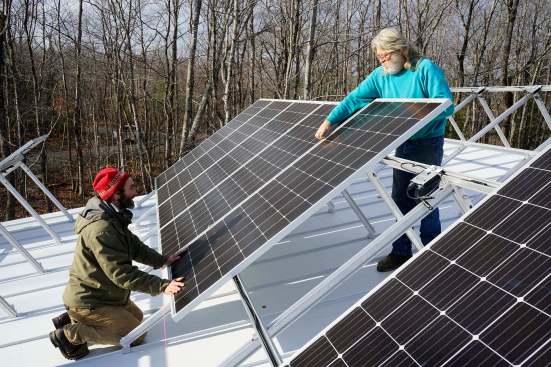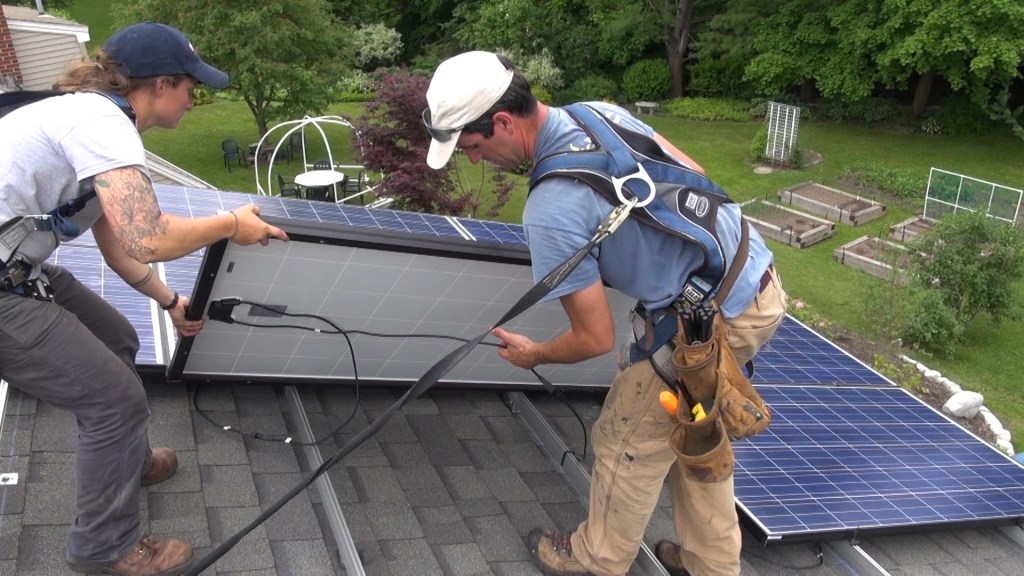The long-threatened U.S. trade action against foreign-made solar panels has finally arrived. “President Trump slapped steep tariffs on imports of washing machines and solar energy cells and panels on Monday, the first major step by the administration to erect the kind of trade barriers Mr. Trump has frequently said are necessary to protect manufacturers in the United States,” the New York Times reported on Wednesday (see: “Trump Slaps Steep Tariffs on Foreign Washing Machines and Solar Products,” by Ana Swanson and Brad Plumer).
“The two solar companies that had sought the tariffs, Suniva and SolarWorld Americas, argue that low-cost imports have decimated American manufacturing of solar cells and modules in recent years,” the Times reported. “Today, 95 percent of the solar panels used in the United States are imported from countries like Malaysia and South Korea, and the companies contend that tariffs are needed to protect the nation’s remaining solar factories.”

David Kelly and Sonny Searles of House Revivers set solar panels on a Bangor, Maine, roof in 2017 (photo by Ted Cushman).
The case is more complicated than that, however: Both of the companies who made the unfair trade complaint are already bankrupt, and neither is actually U.S.-owned. “A bankruptcy filing that set the trade case in motion is signed by Suniva’s Chinese president and four members of its board, who are also Chinese. In fact, Suniva is 63 percent owned by a Chinese conglomerate, Shunfeng International Clean Energy, and in bankruptcy has become deeply indebted to another Chinese company,” reported E&E News in May (see: “Who stands behind Suniva’s trade case?” by David Ferris). The other company in the case, SolarWorld Americas, is owned by SolarWorld AG, an insolvent German corporation, and its assets are on the market, reported PVTech in September (see: “SolarWorld Americas talking with ‘several’ potential buyers,” by John Parnell).
“The biggest winners of President Donald Trump’s decision to slap tariffs on imported solar equipment may not be American manufacturers but a group of investment houses around the globe,” reported Bloomberg (see: “Wall Street, Not American Solar, Stands to Gain From Trump Tariffs,” by Brian Eckhouse). “The tariffs ‘may be about boosting the value of the assets before liquidating them,’ said Hugh Bromley, an analyst at Bloomberg New Energy Finance.”
The administration is framing its decision as an effort to protect American workers: “’Today the president is sending a message that American innovation and manufacturing will not be bullied out of existence without a fight,’ Suniva said on Monday,” reported the Times (see: “Trump’s Solar Tariffs Are Clouding the Industry’s Future,” by Ana Swanson and Brad Plumer). Said Trump: “Our action today helps to create jobs in America for Americans.”
But on balance, the impact of the tariffs on U.S. jobs is unlikely to be positive. “Energy experts say it is unlikely that the tariffs will create more than a small number of American solar manufacturing jobs, since low-wage countries will continue to have a competitive edge,” reported the Times. “Solar manufacturing now represents just a fraction of the overall jobs that have developed around the solar industry. More than 260,000 Americans are employed in the sector, but fewer than 2,000 of those employed in the United States are manufacturing solar cells and modules, according to the Solar Energy Industries Association.”
“Most solar companies in the $28 billion U.S. market opposed the levy, contending it could drive up prices and obliterate more than 20,000 industry jobs,” noted Bloomberg. Some of the opposition has been harsh: “Our entire industry knows that this trade case isn’t about creating jobs or bringing back investment. That’s why no actual American solar company is backing it,” wrote entrepreneur Ryan Reed in an August editorial in the Washington Examiner (see: “Why are two bankrupt solar companies seeking a bailout that would kill their industry?” by Ryan C. Reid). “No, this case is about two bankrupt foreign companies and their hedge-fund backers seeking a multimillion dollar bailout, at the expense of hundreds of thousands of American workers in the thriving solar industry.” Ryan’s company makes steel racking systems for solar power installations in plants in Ohio, Illinois, and Michigan, he writes — “But the viability of my plants, and the entire solar industry, and the jobs it has created, is at risk.”
In California, a strong market for the solar industry, solar power is a big employer, noted the San Francisco Chronicle (see: “Trump’s solar tariff could hit California hard,” by David R. Baker). “Now the solar industry employs more than 100,000 Californians, about 38 percent of all solar workers nationwide,” the Chronicle reported. “The state’s large- and small-scale solar installations, together, can generate more than 20 gigawatts of electricity at full production, roughly the same output as 20 nuclear reactors.”
“California in the past decade lost many solar manufacturing startups — most notoriously, Solyndra — that were unable to compete against low-cost panels from Asia,” the Chronicle explained. “And yet those same inexpensive imports, their prices dropping year after year, fueled the growth of other companies that sell and install solar arrays. Photovoltaic cells even grew cheap enough to be used in large-scale power plants, an idea once considered wildly unrealistic.”
It’s the large-scale power plant projects that will be impacted worst by the tariff, reported The New York Times. “While the tariffs are likely to slow the adoption of solar power in the United States, they will not entirely halt the industry,” the Times reported. “An analysis by GTM Research found that solar installations will continue to rise from 2018 to 2022, though there will be 11 percent fewer panels installed as a result of the tariffs. One reason for the muted effect: Solar cells and modules account for one-third or less of the overall cost of solar systems, and the industry has been relentlessly cutting the costs of all components. All told, the tariffs will increase the cost of utility-scale solar projects by about 10 percent and residential rooftop systems by just 3 percent — raising them roughly to prices seen two years ago.”
In some regional markets, utility-scale solar-powered electricity plants will still make sense. But in others, the tariff’s effect will be to tilt the balance — not in favor of U.S.-made solar panels, but in favor of the more traditional competition: fossil fuels.
